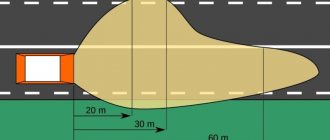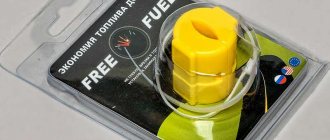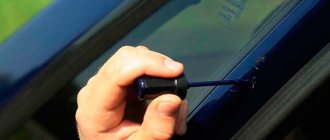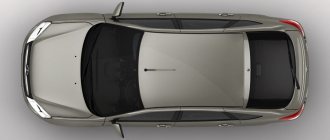What is seasickness?
During movement, the brain receives certain signals. If the vestibular apparatus detects movement, then the rest of the senses ignore this movement. There is a discrepancy between the signals, which leads to a malfunction of the central nervous system, and this malfunction affects the manifestation of the characteristic symptoms of motion sickness: nausea, vomiting, general weakness, sweating.
How to understand that a child is sick?
The following symptoms may indicate that your baby is sick:
- the first unpleasant sensations appear in the stomach, so the baby may complain that it is unpleasant, uncomfortable or painful;
- pay attention to salivation - with nausea, saliva is released more than usual;
- the baby’s skin may be hot and pale, and there is a risk that he will vomit;
- Symptoms may appear and worsen due to strong odors or winding roads. If your baby turns his head or looks at an object that is too close to him, he may also get motion sickness.
Avoid things that may trigger motion sickness.
Classification
In medicine, motion sickness syndrome is called kinetosis. According to statistical data, the population of the entire planet is familiar with this condition. In most cases, it causes seasickness for small passengers.
There are four forms of this condition in total.
- If nervous kinetosis occurs, then the presence of general weakness, constant drowsiness, pain and heaviness in the head, and dizziness are noted.
- In the gastrointestinal form, the following may be present: nausea, possible vomiting, a taste of soap in the mouth, increased sensitivity to various odors.
- In the presence of a cardiovascular form, the following is noted: an increase in heart rate, an erratic rhythm of the heart muscle, an increase in blood pressure.
- Mixed form. Combines two or all three of the above forms of kinetosis.
What will help avoid motion sickness?
In fact, it is better to prevent the disease before symptoms begin. What to do to avoid motion sickness?
- It is better to plan the trip during the child's sleep time. It is unlikely that your baby will get sick while sleeping. If it is unrealistic for a child to fall asleep in a car, you can lay him down on the bed at home, and then carefully transfer him into a car seat.
- Do not read or use gadgets while driving.
- It is better to fix the baby's head with a headrest or a special pillow, as unnecessary head movements can increase nausea.
- To avoid heavy strain on your eyes, you can wear sunglasses or close them.
- You shouldn’t overeat before your trip and eat fatty and spicy foods. Try to drink cool water while moving, and if you want to snack, take dry crackers and cookies.
- Strong odors are a trigger for motion sickness; try to avoid perfume, car deodorants, and smoking.
- If possible, try to stop periodically, get out of the car and breathe fresh air.
- Children over 12 years of age and adults should sit in the front seat, as the view will be of the horizon and not of passing cars.
- On the train and public transport, try not to sit with your back facing forward; it is better to ride in the direction of travel.
- On buses it is better to sit in the first rows, and on airplanes you should choose seats near the wing.
- And during a sea voyage, you shouldn’t stay in the cabin - it’s better to be on deck, studying the horizon.
- Try to make the baby relax: turn on the child’s favorite music, talk about a topic that is interesting to him, play verbal games with the baby - this will distract the baby from thoughts about motion sickness.
Ginger in the form of tea, cookies or lollipops, and acupressure on the inner surface of the arm 3 fingers below the hand can also help with motion sickness. There are even special bracelets that constantly apply pressure to this area. The effectiveness of these methods is questionable, but it may help some people and is unlikely to make things worse.
Characteristic manifestations
Nausea and vomiting are the most obvious signs of motion sickness in transport.
The presence of symptoms such as:
- increase in pressure;
- dizziness that becomes more intense;
- severe weakness;
- attacks of nausea followed by vomiting, as a result of a severe headache;
- At the same time, paleness of the skin may be observed;
- loss of appetite;
- the appearance of apathy or the opposite effect - excitement.
If a child gets seasick
If the baby still gets seasick, then your task is to alleviate the child’s condition.
- Monitor the temperature in the car, do not let your child get too hot. This means that you should not dress him too warmly.
- You can use a small fan to keep your baby cooler, but don't overdo it, or your baby may get cold.
- You can attach a special screen to protect from the sun on the car window so that bright light does not interfere with looking ahead.
- Be sure to evaluate the ventilation in the car. Do not allow strong perfume or food odors.
- Cigarette smoke increases nausea if the child is already seasick, and can also provoke nausea. Do not allow anyone to smoke in the car.
- If your baby vomits, give him a couple of sips of breast milk, formula, or cool water to prevent dehydration.
- If the child has vomited several times, it is better to give a medication for dehydration - a rehydrant, which can be bought at the pharmacy.
- If you suspect your baby might vomit again, cover your baby's chest and stomach with a towel, as it will be easier to remove the towel than to completely change your baby's clothes.
What about medications for motion sickness?
In fact, medications for motion sickness are unsafe and have a number of side effects.
Despite this, the most effective drugs for motion sickness are drugs with Dimenhydrinate, for example, Dramamine, Aviamarin, but they are allowed from 1 year and are prohibited for pregnant and lactating women. It’s up to you to decide whether to give your child such a drug or not, but do not forget to consult with your pediatrician.
It happens that motion sickness strikes for the first time and the child vomits in the car, although this has never happened before. Do not panic! Stop the car, wash and change the baby, calm the child down, because this is a new condition for him. Give your child water, walk in some fresh air, and wait until your child feels better before driving again. Motion sickness is always unpleasant even for an adult, and even more so for a baby. But if preventive measures are observed, it is quite possible to alleviate the child’s condition. Take care of yourself and your loved ones and be healthy!
What to do if you constantly get motion sickness on the road
- Train your vestibular system. It is necessary to resort to balance and coordination exercises. For example, you can go dancing, ride a carousel, or aerobics.
- Eye training. Learn to make circular movements with your eyeballs down, up, left, right, in a circle. Do this exercise several times a day.
- Head rotation can be done both sitting and standing. Looking forward, you need to raise your head up, then move it to your right shoulder, to your left, and lift it up again. Repeat these steps in a circle several times. After this, move on to exercises directed in the other direction. Then start moving your head in a circular motion.
- Turns in place. You need to stand in one place and then turn around yourself. In the initial stages, this can be literally two turns. It is worth gradually increasing their number.
- It is also very important to lead a healthy lifestyle.
Causes of motion sickness
Children get motion sickness more often on car trips - every second child under 12 years old suffers from kinetosis. This is not a disease, it’s just that children have an even less trained vestibular apparatus. Most children outgrow the torture of transport by the time they reach adolescence.
Why did an adult start getting motion sickness in the car, if this had never happened before? The reasons may be either the current state of the body or the circumstances of the trip.
What can enhance kinetosis?
- Diseases of the ears and nasopharynx, impaired hearing. After complete recovery, kinetosis as an additional symptom will go away.
- Weakened vision and lack of suitable lenses or glasses. This is an additional difficulty for the brain - with low vision, trying to fix moving and stationary objects.
- Hormonal changes – for example, pregnancy. After giving birth, the discomfort of traveling may ease again.
- Diseases of the cardiovascular system.
- Stress, fatigue, lack of sleep.
- Age-related changes.
However, it may well be that you suddenly become seasick not due to changes in your health, but due to unfavorable conditions of a particular trip. For example:
- A poorly chosen place - with your back to the direction of travel, near the window.
- It's hot and stuffy in the cabin.
- Shaking while driving is due to a bad road or, for example, poor seat cushioning.
- Watching videos or reading texts from your phone, tablet or monitor in the cabin.
Almost everyone remembers from childhood these unpleasant sensations when they get motion sickness in the car.
What is the vestibular apparatus?
This is a tiny system of special organs of the inner ear that provides balance to the human body. Thanks to the work of the vestibular apparatus, a person determines his position and can move. People owe this device the fact that they are able to sense the direction of movement or the position they occupy.
When we move our head or tilt it, the receptors in the inner ear are irritated. It leads to involuntary contraction of the muscles responsible for maintaining or changing the position of the body. The main task of the vestibular apparatus is to analyze all head movements.
Why do we get motion sickness?
The vestibular system has a well-coordinated connection with the hypothalamus. Only people with increased sensitivity of the vestibular apparatus are susceptible to motion sickness. When riding in public transport, these people lose coordination of movements, they begin to feel dizzy, weak, and nauseous.
See also: 5 tricks to keep yourself occupied at the station while waiting for your flight
Motion sickness is a reaction of the inner ear receptors to movement. In some people this reaction is slow, while in others it is accelerated. It is those who have an accelerated reaction of the vestibular apparatus who get motion sickness during long trips. They may feel sick at the thought of moving. The lucky ones who have a type 1 reaction do not experience the symptoms of motion sickness.
Motion sickness can make traveling a real nightmare. It makes us sick in the following situations:
- travel by bus or car;
- flying by plane, the ship getting into “air pockets”;
- monotonous rocking of the boat on the sea waves;
- roundabout on the carousel;
- riding in an elevator;
- alternate up and down movement when riding on a boat swing.
How to prevent motion sickness
The vestibular apparatus needs to be trained with special exercises to help the body resist motion sickness when traveling in transport. Swimming, gymnastics, and acrobatics are useful.
If you or your loved ones get motion sickness in transport, prepare for the trip in advance. You can avoid painful nausea if you follow certain rules:
- The luckiest ones are those who travel with their own car. At the first signs of illness, you have the opportunity to stop, go out for a breath of fresh air, lie down and relax on the grass;
- Many people stock up on lollipops: sucking lollipops actually prevents nausea. The “Vzletnaya” candy lived up to its name;
- Chewing gum can help - keep the package handy;
- if you have a bus trip, ask for a seat in the front, preferably near the driver. Do not look out the side window, because flashing landscapes will increase irritation of sensitive vestibular receptors. It is best to look into the distance, in front of you. On sharp turns, tilt your body in the same direction;
- It's better to go at night. A long journey is easier to endure at night than during the day. There is a chance that you will be able to sleep and not feel nauseated;
- Don’t eat heavily before your trip, but you shouldn’t go on a long journey hungry. You need to eat 2 - 3 hours before departure;
- be sure to take a bottle of still water. A sip of water will relieve an attack of nausea;
- When flying, buy tickets for seats near the wing - there is the least shaking. Sit near the porthole;
- If it is possible to choose a vehicle, then it is preferable for people with increased sensitivity of the vestibular apparatus to travel by train. You will get motion sickness later than when riding a bus, and the symptoms of motion sickness will be milder;
- For a child who gets motion sickness in transport, take games, puzzles or books so that he can distract himself from contemplating the flickering pillars outside the window. When a child is busy with an interesting activity, time flies quickly, and he may not notice the painful symptoms of motion sickness;
- On the eve of the trip, you need to get a good night's sleep. Go traveling rested;
- in especially severe cases, it is recommended to avoid long travel. It will be smarter than passing out from lightheadedness.
Medications containing Cinnarizine significantly alleviate the condition
How to prevent kinetosis
- If you are sitting in the passenger seat, try to be as close to the driver as possible. It is believed that if you look out the windshield, the likelihood of developing motion sickness will decrease.
- It is not recommended to sit with your back to the traffic.
- If possible, open the window and listen to rhythmic music.
- It is not recommended to eat heavily or drink alcohol before going on a trip, or drink a lot, especially soda.
- If you are sitting near a side window, try not to watch what is happening behind it.
- If you are not a driver, you can try to sleep.
- It is important to ensure that there is no stuffiness in transport.
- You should not watch movies or play on a tablet or phone while driving, as flashing pictures can cause motion sickness even faster.
Now you know, if you start getting motion sickness, what could have preceded it. When choosing the appropriate way to get rid of this condition, it is worth considering what exactly triggered its development. Remember what to do if you already feel seasick, and what can be done to prevent the occurrence of kinetosis.











